
Revision A
T-48 90 008 026
1-6
ns Nanosecond
PAM Pulse
Amplitude
Modulation
PDME
Precision Distance Measuring Equipment
PMCS
Preventative Maintenance Checks and Services
PPM Pulses
per
Minute
PRF
Pulse Repetition Frequency
PW Pulse
Width
PWR Power
RA Resolution
Advisories
Receiver Efficiency
The Test Set’s Measurement of valid replies received. Displayed as a
Percentage.
Reply
Codes
A transmitted response, from the airborne transponder, to an
interrogation. Commercial transponders responses are designated as
either ATCRBS/A where the reply includes the pilot selected 4096 ID
code, or ATCRBS/C, where the reply includes the aircraft pressure
altitude. These same responses for military transponders are designated
as MODE 3A and MODE 3C. The associated intruder type panel
designations on the T-48 is “ATCRBS”.
RF Radio
Frequency
RMS
Root Mean Square
R/T Receiver
Transmitter
SIF
Selective Identification Feature
SLS
Side Lobe Suppression. A pulse transmitted from an omni-directional
antenna, used as a reference level to prevent replies to interrogations
received from the secondary radar antenna side lobes.
Squitter
The self-generated transmissions made by a MODE S transponder, not in
reply to an interrogation, for the use of the collision avoidance system.
Surveillance Altitude
An interrogation that causes only the addressed MODE S transponder to
reply.
Surveillance ID
An interrogation that causes only the addressed MODE S transponder to
reply to its “4096” code.
TA Traffic
Advisories
TACAN Tactical
Air
Navigation
TCAS
Traffic Alert and Collision Avoidance System
TX Transmitter
UF
Uplink Format. The format in a MODE S interrogation that indicates the
type of reply expected.
VORTAC
VOR and TACAN (co-located)
VOR VHF
Omni-Directional
Range
VSWR
Voltage Standing Wave Ratio
WOW Weight
On
Wheels
UUT Unit
Under
Test
XPDR Transponder
XPDR UT
Transponder Under Test
4096 Code
This refers to the octal number dialed into either an ATCRBS MODE A
or MODE S transponder by the pilot. This is to be distinguished from the
address of the MODE S transponder, which cannot be changed.
Further definitions may be found in the following reference books and documents: Helfrick, A.D. Principles of Avionics. Leesburg:
Quality Books, 2000. RTCA/DO-181B. Minimum Operational Performance Standards for Air Traffic Control RADAR Beacon
System/Mode Select (ATCRBS/Mode S) Airborne Equipment. Washington D.C.: 1999. United States. Federal Aviation
Administration. Federal Register Fed 3, 1987 FAA rules Part 91.
















































